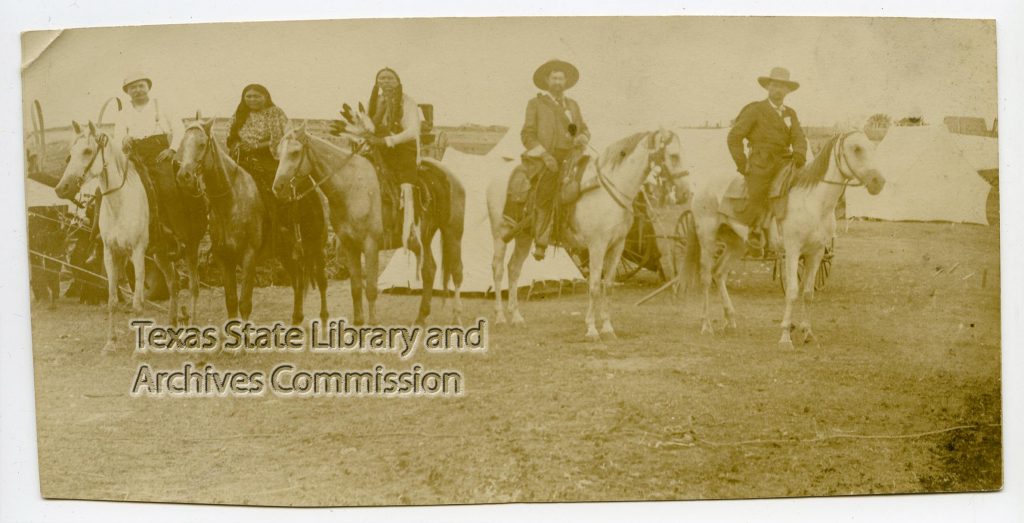— Beginning of Week Three —
As the time frame to select a more centralized research topic approaches, it seems that the more I dig into the “history” found in the Wichita County community is limited, in an immense capacity, when it comes to information based upon the migration and livelihood of any Native American (Indian – as most of the archives held refer to them) in the subsequent region. For me, in an attempt to find more information on the Native groups – the Comanche “Quehada”, Kiowa, Caddo (Wichita and Taovaya) – the experience has been rather stressful. Primary sources are clearly going to be difficult to uncover, but I don’t think I should count myself out just yet, and try a little harder in order to find the primary resources.
Friday morning I visited the Special Collections Room in the Moffett Library, and was assisted by Ms. Bates. Upon inspection and some tedious searches, I came to the realization that there is not a lot of information available about anything related to the Native American history in the Wichita County. Although there is a bit of descriptions or comments made about the Wichita and Comanche (and their subgroups) written within some of the texts of books Ms. Bates was able to retrieve for me, nothing more was left to be uncovered in a detailed search. An interesting quote that I found in a book called, The History of Wichita Falls, by Jonnie R. Morgan, stated that citizenship was limited to only Anglo settlers, and did not include groups like polygamists, Japanese, etc. Additionally, if a child of “American or Anglo American” citizens was born on foreign soil, the child was granted citizenship…BUT… if a woman who was granted citizenship in this manner was to late marry a foreigner or “alien”, then the woman would relinquish her citizenship all in all. In my opinion, this concept and conversation that was portrayed in this book may explain why there may be little information on the Native Americans at the dispense of the regular or student population on a campus where memorabilia, streets, buildings, rooms, and statues are found all throughout said area in memory and respect of these groups of people.
Our next step should be to research further the history of Midwestern State, which I believe if I can remember correctly, Dr. Kindig (a professor from our institution) actually wrote a book over Midwestern’s history. This will shed light onto the situation and allow us to see why these “things” are named as such; an example would be some of our student services rooms in the Clark Student Center knowns as: The Caddo Room, Comanche Suites, Kiowa I & II, Apache Board Room, Cheyenne Meeting Room, among various others, which all serve as rooms for anyone to host events, meetings, or are even offices for some of our Staff / Administration. We also have the “Sunwatcher Plaza – and Sunwatcher Statue“, along with the “Sunwatcher Clubhouse, and Sunwatcher Apartments.“ where students either live or congregate for activities, or pass by these locations while walking to class.
I find this incredibly fascinating.
Who and what determines who a citizen of the city, state, or country as a whole even during that time period? (18th – 19th Century.) Does this concept create a problem for the recordings of history in general? If there is no need found to grant validation to any other group of people other than the Anglo – Americans, it could be possible that this idea explains the lack of historical context, since they (this group of people) are the ones recording history itself.
Although finding adequate primary resources at the Moffett Library was a bust, Ms. Bates informed me that the Wichita Falls archivist Bill Steward (which is located in the Wichita County Archives Downtown) would be a good source to seek out – considering that most of the information available about the Native Americans is found here! So my plan is to go to this location in the following week in order to greater establish an understanding of the Native American’s migration patterns to and from the Wichita Falls area, and the county. I’m really excited to see where this takes me, and never allow myself to get discouraged; for some, these minor setbacks may be a reason to panic and stress them out. But I am a firm believer in giving everything time; you simply cannot rush into things and be surprised when not everything goes well. So I will see where this next week takes me! I look forward to every second of it. I will attach a copy of my annotated bibliography (click the read more section below) so you may read it at your leisure, but it basically helps describe in detail more information that I found over the last few days. I additionally did some digging and found some photographs of Quanah Parker, who apparently had an important (but small) role in the history of Wichita Falls, which I hope I am able to uncover.
Until next time, Maria.
